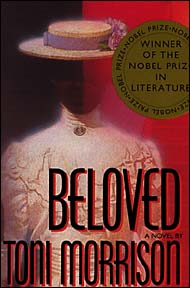Reading: How to Survive the Titanic, or The Sinking of J. Bruce Ismay by Frances Wilson
Listening to: the upstairs sounds of a new day (creaking of floorboards, the closing of a wardrobe)
Outside: Sun! Glorious sun!
So you know we all love a good ghost story. Don't we? Charles Dickens, Shirley Jackson, and Jeet Thayil all know how it's done. And of course, so does Toni Morrison.
And one of the best ones is her 1987 book Beloved. Inspired by the true story of American slave Margaret Garner's 1856 escape from Kentucky (a slave state) to Ohio (a free state), and the realities of the Fugitive Slave Act that drove her to desperation - and notoriety - in her time, Beloved captures the heart of what it meant to be a slave, and how hard it was, even years after the Civil War was over, for ex-slaves to actually live as free citizens of the United States.
Clearly this story has a lot going on. Dedicated to the "Sixty million and more" people who died as a result of the African slave trade, this book maintains a delicate narrative, something elaborate and intricate like lacework, that moves between the past and present effortlessly. Morrison is truly a master in her art: she has poured her heart into something that takes up a mere 276 pages, but speaks for generations of lost heritage, graceless existence and that fragile, bare flame of hope that survives in only a certain few.
One thing that we as readers take for granted here is that one of the main characters is, in fact, a ghost. Her presence is unaccountable; she exists on a plane both different and higher than everyone else. Her strangeness, and how she impacts the other characters, are symbolic, but still part and parcel of the story. We just accept it.
That brings us to genre: how is this still literary fiction if this story wouldn't be able to move forward without a ghost? Isn't paranormal fiction the stuff of King's The Shining, Meyers's Twilight and countless other less-known books destined to stiffen yellow and gather dust at the back of every bookstore shelf?
Is it because Morrison wrote it? Is it because of the complex (but still navigable) narrative structure?
I think it might be a combination of those things, but mostly it's because, unlike King, Meyers, and Countless Others, the conflict here, the main conflict, is internal. The main conflict exists in Sethe, who must revisit the horror of not only what she did, but also the horror of what was done to her.
And that means the ghost is in-between. The revenant in folklore, the animated corpse there to cause havoc but in an even more shadowy, meaningful way. For Sethe, Paul D, and Denver, the ghost is there and not-there, real and imagined, perhaps a spooky drifting of leaves in the woods in back of 124 Bluestone Road. A house, "full of a baby's venom," taken over again.
This story goes beyond folklore - it whispers to you and asks you to think about it.
And so I love this story. And I highly recommend it.
Enjoy your Sunday, all.


No comments:
Post a Comment